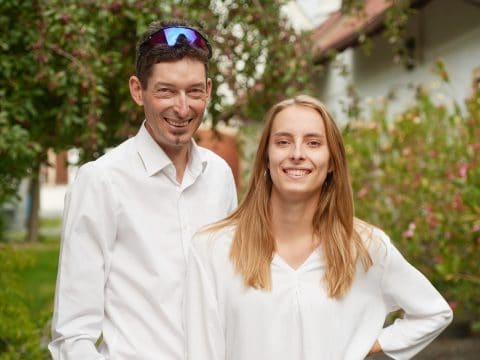Austria’s Reds 2006 – 10 Years Later, Wein.Pur 1/2017
Press
Writing A New Chapter
Red Austrian wines from 2006, ten years later. The expectations were quite varied, but the verdict was unanimous and unmistakeable: a great vintage; one that opened a new chapter in the history of Austrian wine.
Recollections of September 2006 remain fresh: weeks on end of clear, warm and sunny weather with cool nights and clusters that were ripening perfectly. This stretch of weather set a pattern: the autumn of 2006 was just as lovely; perfect conditions persisted into November. These perfect conditions blessed us with many memorable red wines. At the same time, summer wasn’t really all that great; although July was hot and dry, August was as a whole rather rainy. But on the first of September the sun arrived, and hung uncovered in the heavens for an eternally long time. Even at the beginning of November, guests were still sitting outdoors in the Heurigen and other dining establishments.
Powerful and fully ripened wines: that was the result of this unusually lengthy high-pressure system. There was no need for stringent selection in the vineyards, as Andi Kollwentz remembers: ‘Everything simply fell right into place – the grape material was absolutely pristine and healthy.’ He harvested eight hectares of Blaufränkisch in four days from 4–9 October, which is only possible if one can simply cut the clusters off the vine and take them right to the press. Kollwentz’s wines are the most highly rated in the groups Cuvées and Cabernets; Andi loves this vintage to this day, and not only because of the totally easy harvest. ‘The wines are not at all agitated; the tannins are ripe and not too prominent. They are at the same time powerful yet elegantly detailed, and they are just now beginning to offer a great deal of pleasure.‘
Inner Greatness
It is true: many wines are barely showing signs of ripeness: they are fresh and youthful, with firm body, tannins and lively acidity. Any fear that the wines could be too big and broad has been no way confirmed – on the contrary. With their quality and balance the 2006ers rise above the other vintages that we have spotlighted at ten years of age – above all in the number of truly fine wines among them.
While one often speaks of so-called ‘Pinot-years’, by which is meant cooler vintages in which the sensitive Blauburgunders and Sankt Laurents can get to display their full range of delicate nuances and finesse, we can certainly state that 2006 was apparently outstanding for these varietal groups as well. Axel Stieglmar from the Juris Estate looks fondly back on 2006: ‘Good distribution of rainfall, high extract and ripened acidity thanks to the cool nights, which keeps the opulent wines lively as well. We picked the Pinot in Breitenteil rather late on 28 September, but this vineyard is also consistently very late. The vines, then 25 years old, allowed us to max out the potential: three weeks of maceration, fermentation proceeded without any difficulties, and the potential realised itself very well in this’. The pristine grape material allowed Axel Stieglmar and his father Georg to translate their motto into wine: ‘True greatness comes from within. It is our task to never allow the wines to go out of balance. Any cosmetic measures applied in the cellar can certainly make the wines more attractive in the short term, but the makeup flakes off rather shortly. So I am truly glad that the wine is in such good shape.’
Blaufränkisch – What Else?
We were particularly impressed by the number of vigorous and vibrant Blaufränkers – wines that tempted us into swigging down the samples. If the previous ‘Ten Years Later’ tastings did favour the Cuvées – often Cabernet-based – 2006 is the year in which Austrian Blaufränkisch could definitively establish itself as a world-class grape variety. And this was true of the most widely varied growing regions like Südburgenland (Eisenberg), Neusiedlersee Hügelland (Leithaberg), Mittelburgenland – and for the first time, Niederösterreich as well (Spitzerberg in Carnuntum).
Uwe Schiefer, whose Blaufränkisch Reihburg was our highest-rated wine, describes it: ’Simply a superior harvest. 2006 was so uncomplicated, like hardly any other year. In the Reihburg we had only four to five clusters on a vine; with those small berries that’s about one bottle.’ The acidity was rather high for the vintage, at 5.6 g/l, but as Uwe says, ‘On the Reihburg it is always the same, anyway.’ For him the wine was approachable from the very beginning because of its particularly fine tannin structure, and is sure to develop for a long time: ‘The Eisenberg gives us the possibility of making wines capable of long-term ageing, and this also matches my style in the cellar, to intervene as little as possible and allow the wine to find its balance in a natural way. This sometimes requires time, but should always prove worthwhile in the long run.’
And the panel of tasters felt themselves rewarded. We sat for a long time and poured glass after glass from the sample bottles. Impressed with what we had just experienced. and impressed as well that the wines continually got better and more harmonious – and this for up to nine hours after the bottles were opened. We all had the feel of writing a new chapter in the history of Austrian red wine: namely, its arrival in the all-world class.


